
Public policies for land use and water quality are increasingly interrelated. Diffuse nonpoint sources of water pollution, such as farming and forestry, have been difficult to address, and remain the most significant unresolved portion of water quality. Market–based approaches, such as pollution credit trading, are being promoted by many academics as well as government and nongovernmental organizations as mechanisms to help meet water quality standards. In areas where economic growth and land use changes have been occurring, attempts are being made to address nonpoint source water pollution or broader environmental concerns by allowing “trades” or offsets between municipalities under water quality regulatory constraints or seeking opportunities for further growth. Several national and state governmental agencies have developed policies or guidance to support this approach (Abdalla, Borisova, Parker and Saacke Blunk, 2007).
Two experiments using market–like concepts are being tested at the watershed or river basin scale in northwest Oregon. The Willamette River basin contains diverse land uses and has significant economic, ecological and cultural resources. The region currently contains about 3 million people or three–fourths of the state’s population and is expected to undergo significant future growth (Vickerman, 2008).
In the Willamette River basin, two experiments with market–based concepts are underway. The first was initiated about five years ago and is coordinated by a water service district—Clean Water Services. Its focus is on water temperature in the Tualatin River basin. This basin is located adjacent to the rapidly growing Portland metropolitan area. The second was started in 2005 and is being coordinated by the Willamette Partnership, a coalition of municipal, conservation, industrial, agricultural, development, policy and other interests in the Willamette River basin. This project is broader than the Tualatin River experiment, both geographically and in its goals. The partnership has been attempting to use market concepts to achieve other environmental performance goals, including improving watershed health and sustainability, in addition to improving water quality.
Little systematic information has been available concerning performance of water quality programs using market–based concepts and what are critical ingredients for successful programs. This paper fills some of this knowledge gap by assessing available information about the two experiments in Northwest Oregon. Specifically, the key activities and outcomes will be described, along with a number of observations and conclusions. The findings are discussed with an eye toward identifying broader lessons about the performance of land and water public policies that rely on market–based concepts.
Water degradation from rural land uses including farming and forestry is an important problem. Markets are being considered because addressing these nonpoint sources has not been feasible through regulatory or other policy approaches. Reasons for this include the lack of or unclear jurisdiction of the federal Clean Water Act over the rural land uses that are the predominant pollution sources. Also, for many states important issues remain about property rights and the role of government to influence decisions on private land. Market–based approaches have been increasingly considered as it has been recognized that available financial (cost sharing) and technical assistance to farmers or other rural landowners will be insufficient to meet water pollution control and conservation needs.
Water quality issues in Oregon in many ways mirror the national picture described above with several exceptions. First, Oregon’s land use policies, which utilize urban growth boundaries to encourage growth near cities and discourage rural land development outside these boundaries, are among the strongest in the nation. Second, the Northwest United States and Oregon’s environmental policies emphasize protection of endangered species and fish and wildlife habitat. For example, 90% of the Total Maximum Daily Loads (TMDLs) regulations written in Oregon are for water temperature (Bjorn–Hansen, 2007). Third, there has been growth in human population and land development near high value agricultural areas, including counties close to the city of Portland.
Economists have long championed market–based approaches over regulatory “command and control” approaches for addressing environmental problems. Despite its theoretical appeal in terms of realizing cost savings and success reducing the costs of achieving improvements in the air quality, relatively little success has been achieved in the water quality and agricultural land use contexts (Abdalla, Borisova, Parker and Saacke Blunk, 2007). It is useful to look at market–based programs and specifically trading from the vantage point of potential supply and demand for water quality “credits” (King, 2005).Recent changes in conditions that affect the potential supply of and demand for water quality credits suggest a need to reevaluate the challenges that confront trading programs. Among the key challenges to market based approaches that have been identified are: difficulties in setting pollution caps; difficulties in establishing allowable pollution limits (baselines); complexities in establishing credits and associated risks with agricultural credits; transaction costs; enforcing contracts and liability issues; and the scale of the trading program (Abdalla, Borisova, Parker and Saacke Blunk, 2007).
These two experiments using market–like concepts to affect water quality or other environmental outcomes by affecting rural land uses in northwest Oregon provide valuable lessons for land use policy. The assessment of these experiments draws upon information from secondary sources and interviews with program managers and stakeholders.
Water Temperature in the Tualatin River
The first market–based experiment is coordinated by a water service district—Clean Water Services (CWS)—and focuses on water temperature in the Tualatin River watershed. This basin is primarily in Washington County, directly west of Portland, and has been increasingly surburbanized. However, it remains an important agricultural area especially for high–value commodities such as nursery and greenhouse crops (Washington County Extension Service, 2008).
In 2001, CWS faced a federal Clean Water Act requirement (Total Maximum Daily Load- TMDL) to reduce the temperature of effluent from its wastewater facilities. The district considered installing “chillers” at significant costs, estimated at $60 million in capital costs and an estimated $2.5 million to $6 million in operations and maintenance costs (O&M) per year, to meet the requirement. Instead, under authority of a permit negotiated with the Oregon Department of Environmental Quality (DEQ), CWS elected to implement nonstructural methods that included planting of riparian land areas to achieve shade tree credits (Bjorn–Hansen, 2007; Oregon DEQ, 2004)
The elements of CWS’s riparian shade tree credits program included: a capital improvement program; a “Tree–For–All” program for cities; and an “Enhanced Conservation Reserve Enhancement Program” (ECREP) for rural areas. Extensive efforts at quality assurance were made by CWS through close work with local Conservation Districts, tree suppliers and contractors to ensure consistency of trees, plantings, maintenance and monitoring.
Once riparian areas are planted, analysis is conducted to estimate the amount of thermal credit generated by each location. Performance measures and performance goals were defined (Table 1) and are monitored. Success rates are calculated each year based on the ability of each program to meet its established performance target.
In the ECREP, CWS pays farmers with riparian land annual lease payments. In return, the contracted farmers allow CWS, through two local soil and water conservation districts, to plant and maintain riparian areas on the farmers’ enrolled lands. These riparian restoration projects are financed from two sources: federal and state funds distributed through the USDA’s Conservation Reserve Enhancement Program (CREP) and from CWS’s sewer and water service rate–payers. The funds from the district were equivalent to the existing USDA Conservation Reserve Enhancement Program (CREP) lease payment rate, essentially doubling the lease rates per acre to farmers (Bryant and Fenn, 2007). Previous to this program, USDA’s CREP rental payments were insufficient to induce any farmer to participate in CREP (Vickerman, 2008).
The performance of CWS’s riparian tree shade credits program can be measured in quantitative and qualitative terms. Roll, et al. (2008) have done this for the first four years of the five year program. The following discussion draws heavily on their analysis. According to its federal National Pollution Discharge Elimination System (NPDES) permit, the district must have 35 miles of riparian land shaded by tree plantings over five years. Four years into the program, almost 30 miles have been planted, with about 10 miles coming from rural riparian lands enrolled in ECREP. While not required by permit, CWS monitors the program. This has revealed that 82% of the best management practices of tree planting for the ECREP program were meeting performance goals.
Attention to quality assurance and monitoring performance measures has allowed CWS to increase its emphasis on quality over time in ECREP. As a result, the district has become more discriminating in farmer selection. It now uses criteria (e.g., riparian condition, fish habitat, north–south orientation, nutrient filtration potential, habitat connectivity, and potential for water right transfer to in–stream use) to identify land with greatest potential ecological benefit (Roll, et al., 2008).
The outcomes of the ECREP part of CWS’s water temperature trading program can be summarized as follows. The major benefits were a change in farmer behavior leading to 250 acres of riparian farmland being enrolled in ECREP and 10 miles of riparian areas toward a 5–year goal of 35 miles of such land (Roll et al., 2008). The annual program costs for soil rental & other incentive payments to landowners, planting materials, contracted labor and program staff was $3,693/acre (projects in their 1st year) and $2,707/acre (projects during years 2–5)(Bryant, personal communication, 2008).
The direct benefits of the program to CWS were the avoided capital expenses ($60 M) and O&M ($2.5 million to $6 million/year) associated with achieving the temperature reduction through chillers. Another benefit was the added ecosystem services associated with creating shade along stream banks and the river’s tributaries, such as preventing stream bank erosion and creating natural habitat for other species. These added benefits would not have been received by using chillers and they were important to CWS and other stakeholders in the region who supported this program (Vickerman, 2008). This led to broader recognition by environmental groups and other stakeholders of the potential for how ecosystem services might be achieved through market–based schemes.
However, the initial benefits from the trading program should be viewed cautiously. The temperature benefits from riparian shading do not occur at the same time (i.e. the trees must mature to provide full shade), or with the same degree of certainty as the structural option of the chillers. CWS’s quality assurance and monitoring programs are increasing the likelihood that the temperature trading program achieves a high success rate.
The Willamette Partnership is coordinated by a coalition of largely nongovernmental organizations in the large and diverse Willamette River basin. Most members had worked together earlier under the Willamette Restoration Initiative (Primozich, 2005). This newer effort is broad and ambitious in its goals. It is attempting to use market forces to achieve multiple environmental performance goals, including restoring watershed health (Vickerman, 2008).
The Willamette Partnership has focused its efforts on developing an ecosystem marketplace for environmental investments in the river basin. While the effort was initially driven by the need to meet a temperature Total Maximum Daily Load (TMDL), it was broadened to include other environmental performance goals, including ecological resiliency, watershed health and sustainability (Primozich, 2005; Vickerman, 2008). The partnership is exploring other land use changes, such as wetland expansion, retiring flood–prone farmland, and restoring the hyporheic zone along more urban river banks, for their potential to generate temperature reductions.
In 2005, the Willamette Partnership obtained a three–year Environmental Protection Agency (EPA) grant to build the tools to develop and implement the ecosystem marketplace concept within the river basin (Primozich, 2005). Additional funds and in–kind resources were used to implement this project. The coalition’s overall goal was to use the marketplace to drive investments that provide the greatest return to the watershed. Specific means proposed for achieving this overall goal include trading, credit banking, and development of types of ecosystem “currencies.”
In this EPA-funded project, temperature credit trading was seen as an initial way to reduce costs by allowing some dischargers greater flexibility to meet their responsibilities under the temperature TMDL. Credit banking has been proposed to allow parties to document performance related to the TMDL and provide a product that could attract resources in a marketplace where other watershed projects and priority projects not in the TMDL could be addressed.
In addition, several other credit units or “currencies” have been proposed by the project’s leaders, including pollution units and environmental services (e.g., habitat restoration) to meet regulatory requirements from other agencies. Over time the program plans to develop a common currency to be used in assessing the relative benefits of different projects (Primozich, 2005).
Over the past three years the Willamette Partnership developed several important tools, including a synthesis map that brought together previously disparate data, and established conservation priorities intended to foster the development of an ecosystem market place (Vickerman, 2008). Numerous activities, including workgroups, taskforces and conferences, have occurred and tools have been made available to potential users. These actions represent an important focal point for creative study and action around the possibility for market concepts to achieve water quality and ecosystem benefits in the basin. Despite these important steps, the central goal of the partnership to meet the terms of its EPA grant—to complete a temperature trade to help reach the temperature–based TMDL for the watershed—was not reached by mid–2008
Perspectives about the reasons for the lack of achievement of a trade in the Willamette basin differed among agencies and interest groups involved. Lawsuits had been filed against the Oregon DEQ relating to the issuance of the TMDL as well as specific load allocations (Nomura, personal communication, June 2008). Frequently identified barriers included the lack of acceptance of the science behind the TMDL and the perceived lack of fairness of the load allocations to different dischargers in the TMDL. The overall effect of these disagreements was to increase uncertainty and increase the transaction costs to trading. This barrier of high transaction costs has been frequently identified as a barrier in the water quality trading literature (Abdalla, Borisova, Parker and Saacke Blunk, 2007).
Market–based approaches are being attempted to address the difficult challenge of nonpoint source water pollution by allowing trading between municipalities under water quality regulatory constraints and farm or forest landowners. Based on an assessment of available information from two ongoing experiments with market concepts in Northwest Oregon, several policy implications can be drawn.
A necessary condition for innovative market–based approaches is a supportive organizational environment and resources. EPA Region 10 and the Oregon DEQ were flexible in terms of their regulatory approach to issue water quality permits and willingness to take risks with an unproven market–based experiment to address water quality degradation. The USDA and a number of other federal and state/regional agencies and organizations provided resources and technical assistance that significantly contributed to the Tualatin River program’s achievements.
Allowing staff the time and flexibility to explore such innovative approaches is one key to success. Innovative projects are typically considered by state agencies as something to do in one’s spare time or a luxury to be funded in better budget times. To overcome this, the initial grant that funded the Tualatin River pilot program allowed Oregon DEQ to devote staff time to fostering and developing this project (Bjorn–Hansen, 2007)
Significant resources have been put into the water temperature trading program coordinated by Clean Water Services in the Tualatin watershed and the proposedecosystem services marketplace coordinated by the Willamette Partnership. In both cases, a significant amount of activities occurred. But only in the case of the Clean Water Services program have on the ground land use changes occurred and some intended outcomes been realized. Moreover, it is critical to discern between program activities and actual behavioral, land use or water quality outcomes achieved when assessing market–based experiments in environmental protection.
Much greater success was achieved in the Tualatin watershed, which was geographically smaller and contained fewer, generally more homogeneous municipalities and land uses relative to the more diverse and complex Willamette River basin. In addition, the program run by Clean Water Services in the Tualatin focused on the water quality parameter of temperature and observable best management practices that were correlated to water improvements and their associated benefits to fish and wildlife. One should remember though that the Tualatin pilot project has been in existence for three years longer than the Willamette Partnership.
Disagreements about science and regulatory issues increase uncertainty and transaction costs and thereby act as a barrier to market–based approaches. In the case of the Tualatin watershed, important stakeholders, including environmental groups, did not challenge the science behind Total Maximum Daily Load (TMDL) numbers. In the Willamette River basin, important stakeholders have disagreed about scientific, legal or fairness issues related to the TMDL for the river basin, leading to considerable uncertainty and increasing transaction costs.
Some observers have pointed to the leadership, financial and organization capacity of government agencies as the ingredients for the achievements of the Tualatin watershed temperature trading program.
Federal and state regulatory agencies clearly play a critical role in fostering innovative market based projects. They need to strike a balance between holding the municipal or other permit holder accountable to meet the environmental program’s goals and being flexible enough to accommodate the learning experience which will inevitably occur as the projects are implemented.
At the local level Clean Water Services’ willingness to take a leadership role and persistence in bearing the significant transaction costs of trying a new approach were a key reason for the project’s success. In addition, the special district’s organizational and technical capacities and willingness to innovate and learn were evident, especially in its efforts in quality assurance and follow–up monitoring and evaluation. Clearly, paying attention to implementation details and learning from mistakes is critical to making market–based programs work. These needed follow–up steps can be costly. Clean Water Services had the organizational capacity and committed the resources to pay attention to these necessary program ingredients to ensure that the intended outcomes would be realized. Others considering market–based programs need to be acutely aware of the realities of implementation, monitoring and learning, and to ensure that some organization is committed to “follow through” and evaluation.
Abdalla, C., Borisova, T., Parker, D. and K. Saacke Blunk. (2007). Water quality credit trading and agriculture: Recognizing the challenges and policy issues ahead. Choices. Second Quarter, June. http://www.choicesmagazine.org/.
Bryant, A., (June 16, 2008). Tualatin Soil and Water Conservation District, personal communication.
Bryant, A. and K. Fenn. (2007). Tualatin Soil and Water Conservation District, Hillsboro, OR annual report.
Bjorn–Hansen, S. (2007). Oregon Department of Environmental Quality. Water quality credit trading in Oregon: A case study report. July 27. www.deq.state.or.us/wq/trading/docs/wqtradingcasestudy.pdf
King, D.M. (2005). Crunch time for water quality trading. Choices, 20(1): 71–75.
Nomura, R. (June 13, 2008). Policy Analyst, Oregon Department of Environmental Quality (DEQ)—Western Region, Eugene, Oregon, personal communication.
Roll, B., Cordon, B., Guillozet, P., Petersen–Morgan, K., Vaughn, B. and K. Smith. (2008) Sustainable integrated watershed management in the Tualatin basin. Clean Water Services, Hillsboro, Oregon.
Oregon Department of Environmental Quality. (2004). Clean Water Services (CWS) Watershed–based NPDES Permit; http://www.deq.state.or.us/wq/wqpermit/cwspermit.htm
Primozich, D. (2005). Development of a marketplace for environmental investments in Oregon’s Willamette River watershed. Willamette Partnership. Salem, OR. Proposal to US EPA. March.
Vickerman, S. (2008) “Mitigation, brokering, bargaining, and bartering natural resources: Building an ecosystem marketplace in Oregon’s Willamette basin” Defenders of Wildlife, West Linn, OR, May.
Washington County Extension Service. (2008). 2007 Washington County estimate of agricultural commodity sales, March.
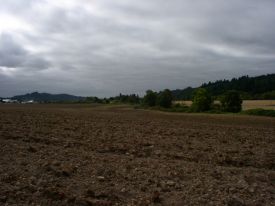
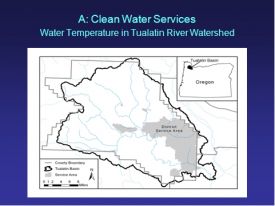
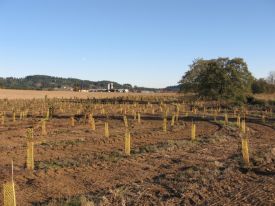
| Parameter | Measure | Performance Target |
| Native Tree and Shrub Density | Tree and Shrub Counts | 60% of tree and shrub target stocking density by Year 5. Stocking density rates are unique to each plant community type. |
| Invasive Species Cover | Visual estimation of aerial cover | Target species are placed in cover categories and evaluated to ensure cover does not increase over time. |
Source: (Roll, et al., 2008).
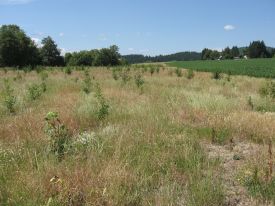
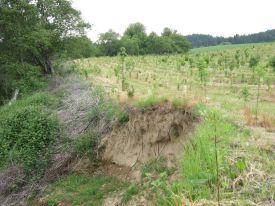
Appreciation is extended to Autumn Bryant, Landowner Incentive Program Manager, Tualatin Soil & Water Conservation District, Hillsboro, Ore. who provided the photos used in this article.